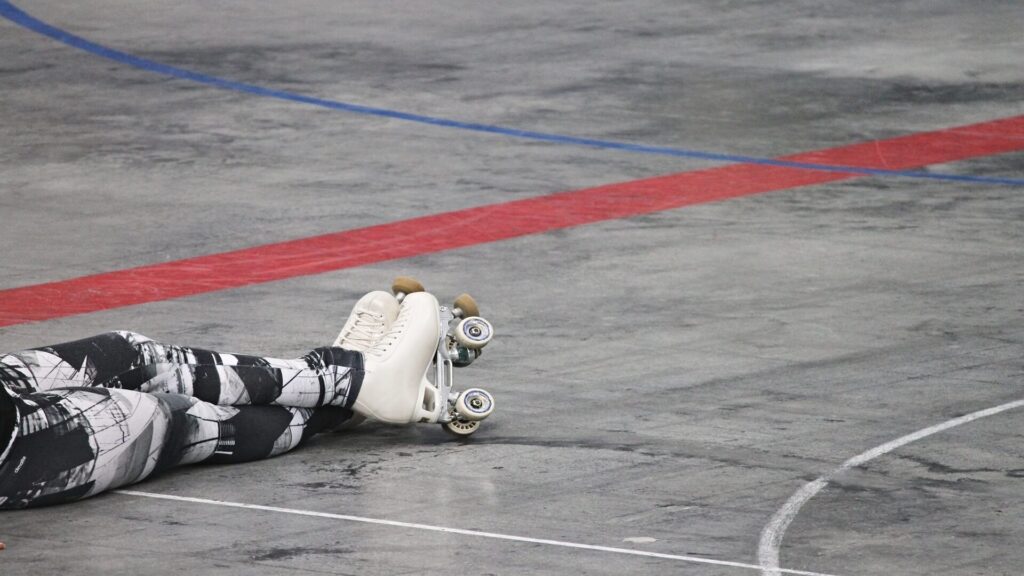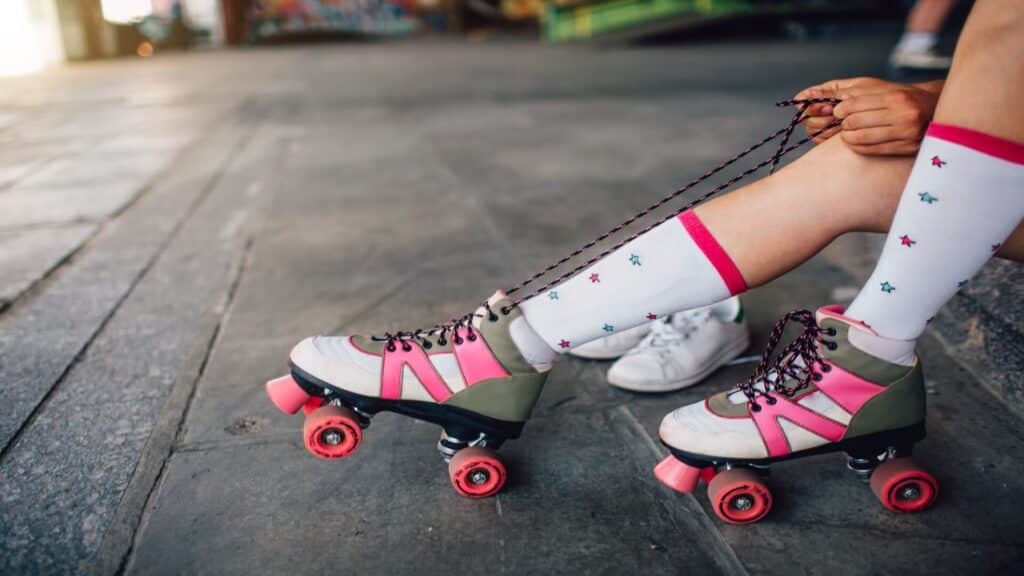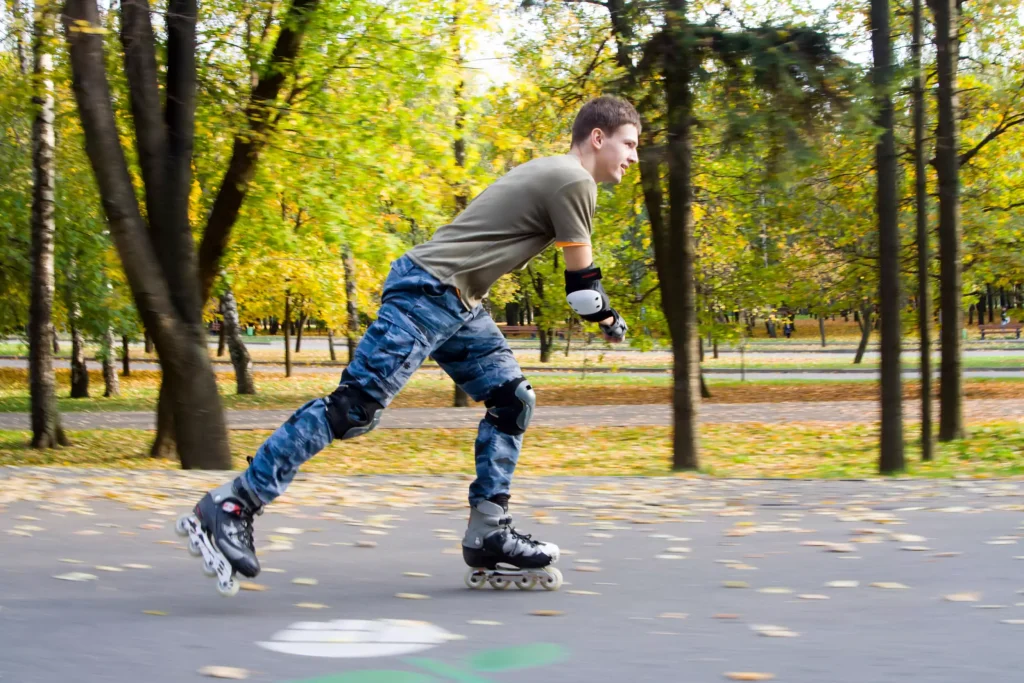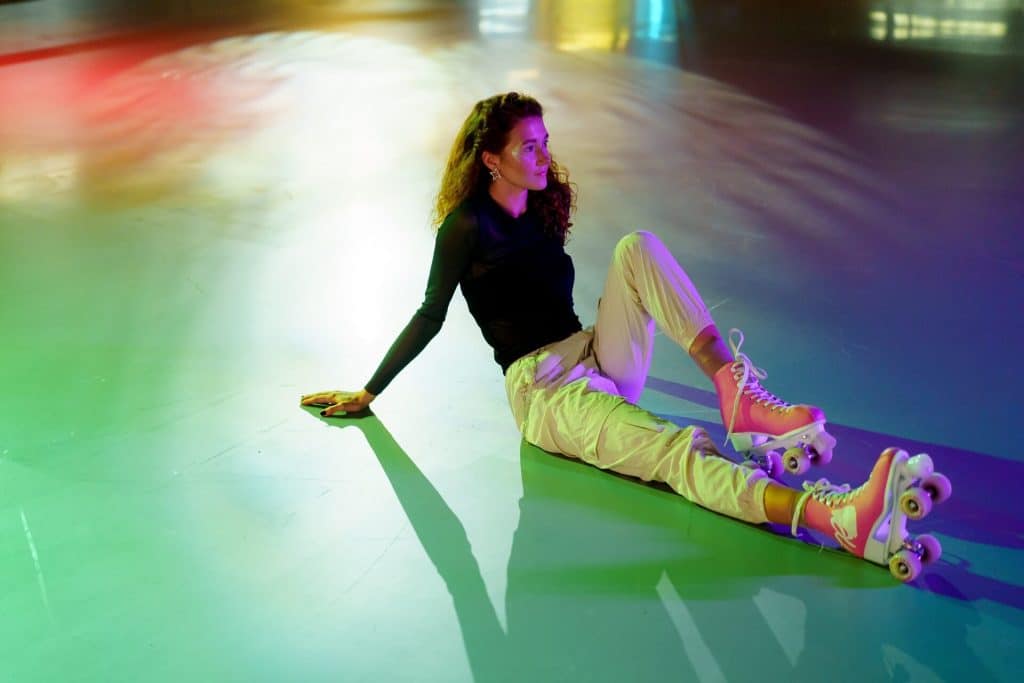Roller skating has made a resurgence in recent years, offering a fun way to stay fit and socialize. One question that often arises for new and experienced skaters alike is, why do roller skates have heels? This article will explore the history, science, and style behind heeled roller skates, helping you understand their unique design and functionality.
Table of Contents
- History of Roller Skates
- Type Of Skate – Quad vs. Inline
- The Difference Between Heeled Roller Skates and Flat Roller Skates
- How Heel Height Impacts Skating Disciplines
- Functionality: Why Do Roller Skates Have Heels?
- Style: Heels and Roller Skate Fashion
- Tips for Selecting Your First-Heeled Skates
- Conclusion
- FAQs
History of Roller Skates
Early roller skate models consisted of simple wooden platforms mounted on wheels. Without a heel or boot, these primitive skates offered little in terms of control or stability.
Key Advancements in the 1800s
In the 1840s, new innovations emerged, including pivoting rubber wheels and leather strap bindings to secure the skate to the foot. This allowed for basic steering and maneuvering.
The Introduction of the High Heel
The first roller skate with an elevated heel was patented in 1863 by American inventor James Plimpton. Plimpton’s design featured a leather skate boot and four wheels in the same plane. The high heel was a major breakthrough, enabling skaters to lean forward in the skate boot for better balance and control.
Evolution of Quad Skates
Over the next few decades, variations on Plimpton’s heeled quad skate dominated the market. Improvements included metal wheels with ball bearings for a smoother ride and plates that allowed the skater to turn by shifting weight between wheels.
The Arrival of Inline Skates
In the 1980s, inline roller skates were introduced, with wheels arranged in a single line rather than side-by-side pairs. While inlines initially had flat configurations, heeled models soon emerged, offering the same benefits of stability and maneuverability.
Modern Innovations
While the basic heel boots have remained relatively constant, roller skate manufacturers continue to develop new technologies that impact overall performance.
Advanced materials like carbon fiber, aircraft-grade aluminum, and shock-absorbent polymers have increased skates’ durability, responsiveness, and energy return.
Innovations in boot construction, like heat moldable liners, allow for a more customized, precise fit around the heel and ankle. This improves power transfer and control.
Some skates feature articulated heel and toe pieces that pivot independently, adapting better to uneven terrain and providing more ankle support.
New bearing lubrication technologies reduce friction and wear on wheels, making the ride feel smoother and faster regardless of heel height.
While heels provide core stability, these modern component upgrades optimize power, precision, and versatility – especially important for competitive skaters. However, core heel design principles remain foundational.
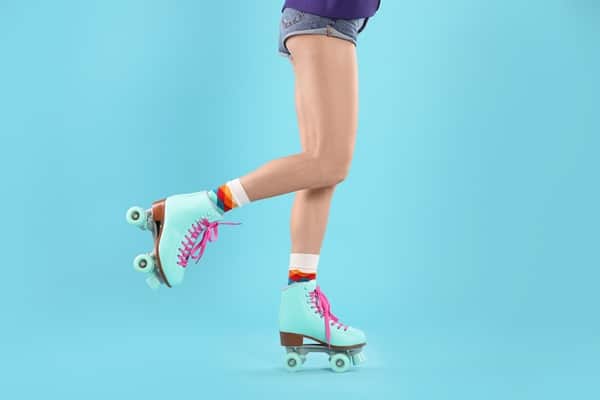
Type Of Skate – Quad vs. Inline
There are key distinctions between traditional “quad” skates and inline skates when it comes to heel design.
On quad skates, the wheels are arranged in side-by-side pairs under a single solid heel/sole piece. This provides stability but reduces maneuverability compared to inlines.
With inline skates, wheels are arranged in a single line under separate heel and toe pieces. This allows the heel and toe to flex independently, increasing control and agility.
Quad skate heels are typically higher and more pronounced. This adds stability for artistic and recreational skating. But it limits power transfer for speed.
Inline heels are lower profile to optimize power and speed. However extra padding is often added for shock absorption since the heel is less supported.
For beginners, quads are preferred for their built-in stability. Intermediates benefit from inlines’ increased maneuverability. Advanced skaters utilize both for their specific advantages.
Understanding these key engineering differences allows skaters to select the right skate construction and heel design for their ability level and preferred skating style.
The Difference Between Heeled Roller Skates and Flat Roller Skates
While heeled roller skates are a popular choice, it’s essential to acknowledge that flat skates (also known as low-cut or speed skates) also have their unique features and benefits. By understanding the differences between these two types of roller skates, you can decide which style best suits your needs and preferences.
Design and Appearance
The most obvious difference between heeled and flat roller skates is their design. Heeled roller skates have a raised heel, while flat roller skates feature a more level, low-cut design. This difference in design impacts the skater’s stance and the overall skating experience.
Balance and Stability
As discussed earlier, heeled roller skates improve balance by shifting the skater’s center of gravity forward over the ball of the foot. This forward lean positions weight over the ball of the foot, which provides better control and stability while skating. The ball of the foot can grip the skate better to aid maneuvers. In contrast, flat roller skates create a more neutral, level stance with weight distributed across the whole foot. Some skaters may find this flat-footed stance more comfortable and natural, while others might prefer the forward-leaning ball of the foot position that heeled skates enable.
Maneuverability and Performance
Heeled roller skates are designed for enhanced maneuverability, with the raised heel allowing skaters to pivot more easily and execute agile movements. On the other hand, flat roller skates are often designed for speed and endurance. Their low-cut design and lightweight construction make them ideal for skaters prioritizing straight-line speed over intricate movements.
Intended Use and Skating Styles
Another significant difference between heeled and flat roller skates lies in their intended use and the various skating styles they cater to. Heeled roller skates are versatile and suitable for various disciplines, including artistic, rhythm, and recreational skating. They are also popular among roller derby players due to their improved maneuverability and stability.
Flat roller skates are often preferred by speed and jam skaters who require lightweight, responsive skates that enable quick acceleration and maximum agility. These skates are designed for smooth, uninterrupted skating rather than intricate moves and jumps.
Comfort and Personal Preference
Ultimately, the choice between heeled and flat roller skates comes from personal preference and comfort. Each style offers its unique benefits and drawbacks, so it’s essential to try both types and determine the most comfortable and natural for you. It’s also worth considering the type of skating you plan to do most, as different styles may be better suited to specific disciplines or activities.
In conclusion, the differences between heeled and flat roller skates extend beyond their appearance. While heeled roller skates offer improved balance, control, and maneuverability, flat roller skates are designed for speed and a more neutral stance. By considering your preferences and skating goals, you can choose the right type of roller skate to enhance your experience and maximize your enjoyment on the rink.
How Heel Height Impacts Skating Disciplines
The height of a roller skate’s heel can significantly influence performance across various skating styles and disciplines.
For artistic and rhythmic skating, a higher heel provides the balance needed to smoothly link steps and turns together and perform complex footwork sequences. The extra height enables skaters to roll through movements like crossovers and mohawks with fluidity and precision.
Alternatively, speed skaters prioritize a lower heel to maximize power transfer and acceleration. A flatter design keeps their center of gravity lower, generating speed from longer, stronger pushes. Minimal heel elevation also reduces instability at high velocities.
Aggressive skaters who perform tricks and stunts generally prefer a moderate heel height. Too high of a heel can make landing aerial maneuvers unstable, while a fully flat setup reduces control. A heel in the 30-40mm range allows for maneuverability without sacrificing stability on jumps and grinds.
For roller derby, a heel in the mid-high range gives skaters the edging, grip, and agility required for this contact sport, while still allowing for speed and endurance. Heel elevation is also crucial for roller derby blocks, providing the leverage to effectively knock opponents off balance.
In general, recreational outdoor skaters can benefit from a moderate heel, providing a blend of control, stability, and versatility across changing surfaces. However, personal preferences and skating style should always be considered.
Functionality: Why Do Roller Skates Have Heels?
Roller skates primarily have heels to improve balance, control, and maneuverability while skating. Let’s dive deeper into the science behind this innovative design.
Physics and Mechanics
The physics and mechanics behind wheeled footwear help explain how the heel of a roller skate improves critical elements like balance, control, and agility.
Center of Gravity
A higher heel shifts the skater’s center of gravity slightly forward. This centers the individual’s weight over the wheels, rather than behind them. Having the center of gravity aligned with the wheels makes it easier to maintain balance and equilibrium while in motion.
Leverage
The added heel height also provides key leverage for maneuvering. Pressing the elevated heel down assists with pivoting turns. The angle enabled by the heel allows skaters to more readily transfer energy into rotational momentum.
Weight Distribution
Heels improve stability by distributing a skater’s weight across a larger surface area. More wheels share the load, lowering pressure on any single point. This makes handling irregular terrain and shock absorption smoother.
Edge Control
An angled heel adds an edged contour to the wheels, providing more traction and grip for tighter turns, stops, and crossovers. This edge control is essential for agile maneuvering. A flat setup removes this advantage.

Style: Heels and Roller Skate Fashion
Another reason why roller skates have heels is their stylish and distinctive look. Heeled roller skates are an iconic and fashionable choice, with many skaters embracing the classic design.
Skating Fashion Trends
The roller skate heel has influenced numerous skating fashion trends. Over the years, we’ve seen disco-inspired roller skate designs, vintage looks, and even the resurgence of the classic “quad” skate. Heeled roller skates have been associated with different subcultures, from the disco era to modern-day roller derby.
Customization and Personal Expression
The question of why roller skates have heels relates to personal expression and customization. Heeled roller skates are available in various colors, designs, and materials, allowing skaters to choose a style that reflects their personality. Many skaters customize their skates with unique laces, wheels, and accessories to create a truly unique look.
If you wish to customize your skates, you can read this guide about how to customize roller skates to get some ideas.
Tips for Selecting Your First-Heeled Skates
If you’re new to roller skating, choosing your first pair of skates can seem daunting. Here are some key factors to consider when selecting heeled skates as a beginner:
- Heel height – A heel of around 30-40mm is a good place to start. Too high and you may feel unstable, too low and you’ll lose maneuverability.
- Wheel size – Larger wheels (70mm+) roll over cracks/debris easily. Smaller wheels (65mm-) offer more agility. Aim for 68-72mm as a versatile beginner size.
- Boot support – A snug, supportive boot provides stability and response. Padding over the heel and ankle is ideal.
- Plate and truck – Nylon plates with adjustable trucks offer good turnability without excessive looseness.
- Fit – heeled skates should fit snugly without pinching. Wear thicker socks to account for the break-in period.
- Intended use – Artistic/jam skating may prefer a higher heel. Rinks or outdoors may do better with lower heels.
Getting properly fitted at a skate shop is wise to ensure you select the right skate specifications for your foot size, shape, and skill level. Consider renting first to try different styles. With the right-heeled skates, you’ll be rolling in comfort and style in no time!
Conclusion
In conclusion, the answer to the question, why do roller skates have heels? lies in the balance, control, and maneuverability these unique designs offer. The raised heel allows skaters to shift their weight forward, improving stability and enabling more agile movements. Furthermore, heeled roller skates are an iconic and stylish choice, giving skaters the opportunity to express their individuality through their skate design.
Ultimately, whether you’re a beginner just starting your roller skating journey or an experienced skater looking for an edge in performance, heeled roller skates are a fantastic option. By understanding the history, science, and style behind this classic design, you can appreciate the benefits and charm that heeled roller skates bring to the skating world. Happy skating!
FAQs
Question: When were heeled roller skates first introduced?
Answer: Heeled roller skates were first introduced in 1863 by American inventor James Plimpton.
Question: How do heeled roller skates enhance maneuverability?
Answer: The raised heel design allows skaters to make tighter turns, achieve greater speed, and perform more advanced moves by helping them pivot on the toe for quick, agile movements.
Question: Why are heeled roller skates considered fashionable and stylish?
Answer: Heeled roller skates are considered fashionable and stylish due to their iconic and distinctive look and their association with various subcultures and fashion trends throughout history.
Question: Can I customize my heeled roller skates?
Answer: Yes, you can customize your heeled roller skates with unique laces, wheels, and accessories to create a one-of-a-kind look that reflects your personality and style.
Question: Are heeled roller skates suitable for beginners?
Answer: Heeled roller skates are suitable for beginners, as they offer improved balance, control, and maneuverability that can make learning to skate more enjoyable and accessible.
Question: Do heeled roller skates offer any benefits for competitive skaters?
Answer: Yes, heeled roller skates provide an edge in performance for competitive skaters by allowing them to maximize power, generate more speed, and perform advanced techniques such as jumps and spins with greater ease.





